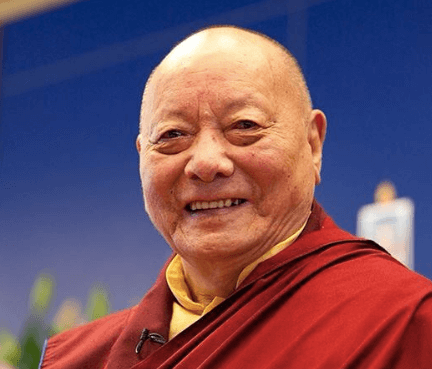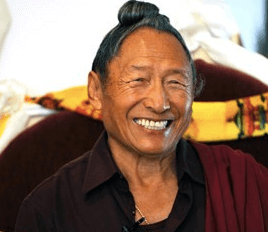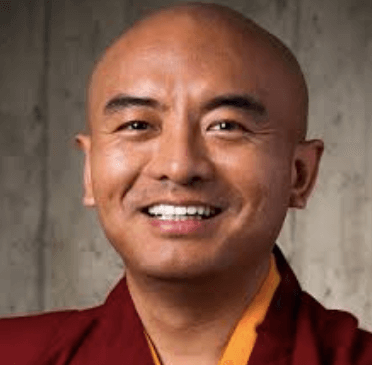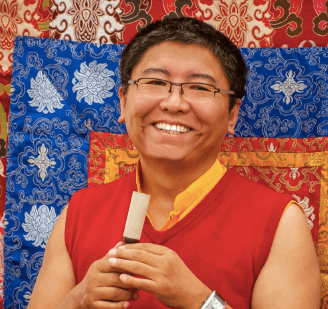I feel this question is just as important since we often want to include our loved ones in our experience. I hope these answers motivate you to connect with your love ones and relieve your worries over death.
Try to be with them, and be simple and genuine. Tell them you love them, that you’re here for them.
Tell them not to over-react to anything, that the journey will be okay. Tell them not to be attached to anything.
Meditate with them if possible, keep it simple, shamatha or vipashyana. Love them. – Chökyi Nyima Rinpoche

Reminding them that death is not a big deal, and creating a peaceful environment. An environment where openness, kindness, and love fill the space.
The most important thing is to help anyone who is dying to relax. Doesn’t matter what religion, or no religion. That’s the most important thing.
Help them relax and have some kind of positive environment, and positive thought processes. –Dzogchen Ponlop Rinpoche

There are two things involved. First, it would be great to have a master who can guide the person during their death, and can give advice on how to concentrate during death.
The other thing is that the practitioner may already have preparation, in terms of having read the bardo books or different commentaries, and therefore already know what to do.
Again, I can’t emphasize enough the importance of preparation before death. Without preparation, at the time of death, especially when going through the bardo, you won’t be able to recognize the deities when they arise because you have not purified yourself and accumulated enough merit. – Khenpo Karthar Rinpoche

It is good if someone can read or remind the dying person to practice the teachings on the six bardos. In addition, try to remember these six things: remember the view, remember the deity, remember mantra, remember your samaya, remember your faith and devotion, remember love and compassion. It is also helpful to remember the Nyingma forms of liberation: liberation through taste (and the blessings substances, the relics), liberation through touching, through hearing, through seeing, through remembering and through wearing. One can also read the Aspiration Prayer of Samantabhadra, or the Coppered-Colored Mountain prayers—that can all be really helpful.
It is also very helpful to give teachings that will help them recognize the bardo of dharmata, and to help them remember phowa. Practitioner or not, remind them to focus at the top of their head. You can also touch up there, or pull a little hair. Remember not to touch any lower parts of their body. Feeling directs consciousness, and it can make the consciousness exit from a lower door, and take rebirth in a lower realm. You want consciousness to exit from the crown, and merge with luminous emptiness awareness, so that your consciousness becomes vast like the sky. Reminding them of this is very helpful. There’s also the recitation of all the Buddha’s names, and the Chöying Dzö [Treasury of Dharmadhatu], by Longchenpa (which is what I usually recite). The root text is good to read. – Lama Tarchin Rinpoche

Encourage the dying person.
Remind them to think of their teacher.
Remind them of their Dharma practice.
Encourage them to recognize ground luminosity. – Mingyur Rinpoche

You can go near the dying person and feel compassion, immense compassion, and pray to your root guru, pray to whoever you have a wisdom connection with. This immense compassion is extremely beneficial for the dying person.
It is said there are four things you can do: if you have a statue of Guru Rinpoche, keep it in front of the person who is dying, show it to him or her. By just seeing it, one can eliminate the person’s suffering, and prevent them from going into the three lower realms. Secondly, one can read The Tibetan Book of the Dead, let the person hear it, this is extremely beneficial. Don’t be shy about reading it loudly, so they can hear it. They can still hear it, even if they may be in a coma. Make sure they can hear what you are reading, which can bring about liberation. That is the meaning of the bardo thödrol [“the great liberation through hearing in the bardo”].
By reading the bardo thödrol to them when they are dying we can remind them: “Now you are going to encounter this kind of experience, so you have to be careful. You may encounter hallucinations, there is no need to be afraid.” Do not get attached to the hallucinations that arise, or be afraid of them. This is telling them to prepare for what they may see and experience, which is very important. Before the person dies, make sure you read the instructions of this book to them.
Once the person dies, the outer breath ceases, but the inner breath continues for about ten or twenty minutes. The sign that the inner breath continues is that they remain warm. If you can reach your spiritual masters during this time of the inner dissolution, this is the best time for them to do phowa for the person. This is when it is most effective because consciousness is still in the body and it makes it easier for a Lama to eject the consciousness.
After the person dies, consciousness dissolves into the heart, and at that moment the person faints, like falling into darkness. It depends on the individual, some people faint for one hour, others for half an hour. During that time, phowa is very effective if done by a high master. If there is no phowa, consciousness will eventually go away from that darkness. Then it is very difficult for the master to do phowa. If the dead person doesn’t receive phowa, they wake up after death and often do not know whether they are dead or not. Because we are habituated, with all the things we do normally, we continue to try to do the same old things after death.
–Namkha Drimed Rinpoche

It varies from person to person. There are different paths and people believe different things. Generally, there will be a lot of experiences after death, so try to become familiar with what is going to happen so that you are more prepared when the different visions come. It’s like preparing to recognize a dream to be a dream. When you recognize that you are dreaming, you are no longer afraid of what happens in the dream.
You can guide it, you can grow from it. It is the same thing with the dying process. If you understand, if you have the knowledge of the bardos—what the bardos are, what the visions are, what they mean—then you will have confidence. So during life you should learn about the bardos and practice for the bardos, become familiar with them. And even test some of those experiences in the dream, using dream yoga to prepare, so that when you encounter these visions after death you will be ready.
It is also good to resolve any family conflicts before death. You don’t want to carry those conflicts into the bardo. This conflict resolution is probably even more important than drawing up legal wills. – Tenzin Wangyal Rinpoche

At the time of death, you should try to meditate on bodhichitta and maintain an attitude of kindness.
You should not be attached to your wealth, possessions, friends, or family, and those around you should not talk about inheritances or your possessions.
It is best if you can study the bardos in advance, and prepare for what you will encounter when you die.
There is a great deal of literature on the bardos, and by spending time with it now you will know what to do when you are dying.- Thrangu Rinpoche

There are several options here. One option is that if you have a yidam [meditation deity], you can grab onto that. By doing so, the yidam binds your mind. Again, whatever is happening, whatever is dissolving, the best thing is to maintain the unborn mind, the recognition of the nature of mind. Don’t be afraid of the dissolution. Things may be dissolving, but you are resting in the nature of mind which is beyond dissolution and death.
The helping person has to have some kind of intuition, and be able to adjust according to the person who is dying. If they are Christian, say something to connect them to God. If they are Buddhist, then say something to help them connect to the underlying mind. If they are a free thinker, then help them connect with the peace in their mind, and to let go of fear. You have to see and understand the person in order to know how to best say: relax, let it go.
Provide what gives them hope beyond life—whether it’s God, the Pure Lands, or the undying and unchanging mind. Most importantly, the helping person needs to use their intuition and wisdom to properly convey what they understand, and to match the belief of the dying person. – Tsognyi Rinpoche

Excerpts from the book “Preparing to Die: Practical Advice and Spiritual Wisdom from a Tibetan Buddhist Tradition”.
On addition to “What’s the best way to help others as they die”, also check out “What Is the Best Way to Prepare for Death?”